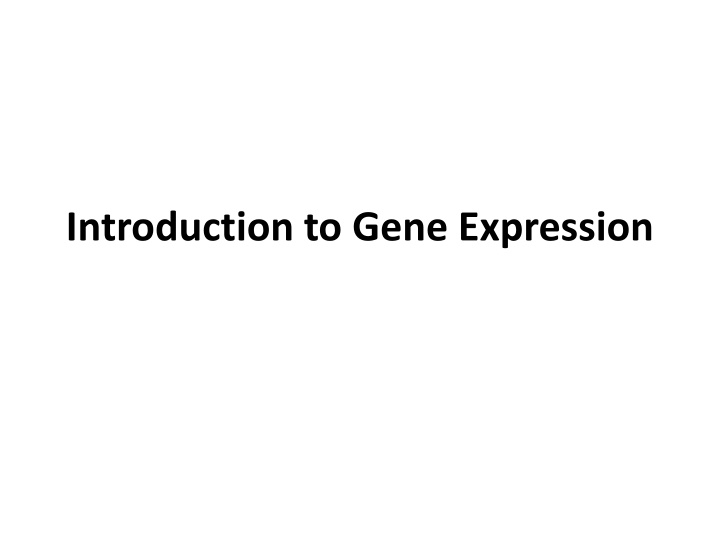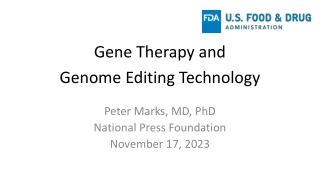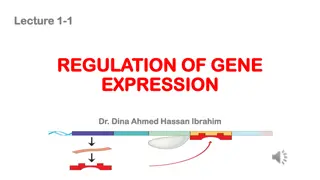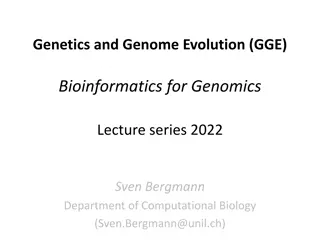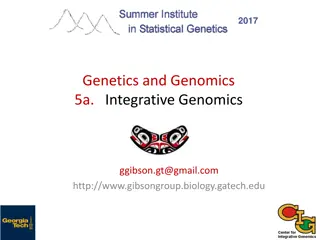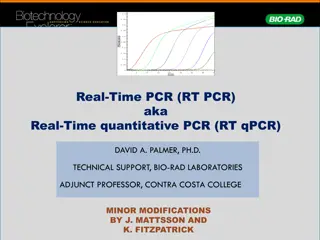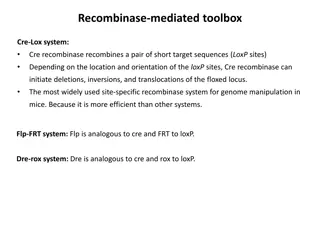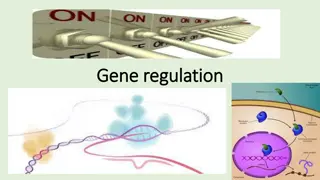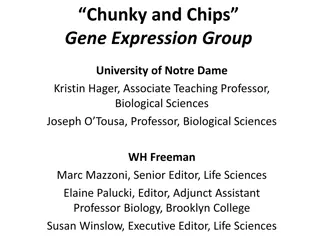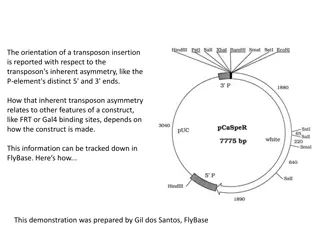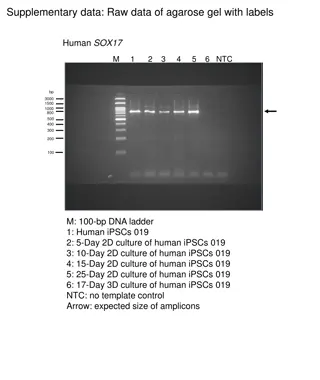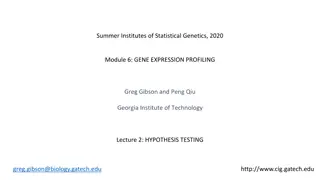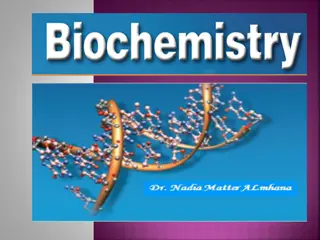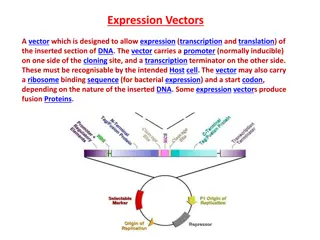Gene Expression and Genome Basics
Delve into the introduction to gene expression, genome, chromosomes, genes, and chromatin, exploring the fundamental concepts in molecular biology. Learn about the structure of DNA, RNA, and proteins within the context of gene expression, along with key terms and assessments in the field. Discover the intricate details of chromosomes, chromatin, and the central dogma guiding molecular biology.
Download Presentation

Please find below an Image/Link to download the presentation.
The content on the website is provided AS IS for your information and personal use only. It may not be sold, licensed, or shared on other websites without obtaining consent from the author.If you encounter any issues during the download, it is possible that the publisher has removed the file from their server.
You are allowed to download the files provided on this website for personal or commercial use, subject to the condition that they are used lawfully. All files are the property of their respective owners.
The content on the website is provided AS IS for your information and personal use only. It may not be sold, licensed, or shared on other websites without obtaining consent from the author.
E N D
Presentation Transcript
Grade Distribution No. Methods of Assessment Marks (%) -1stcontinuous assesments 1 25 -2ndcontinuous assesments 2 25 3 Quiz assessments 10 3 - Final Exam 40
Exam dates and time CAT1: Monday 26/12/1435, 20th of October from 11-12. CAT 2: Wednesday 11/2/1436, 3rd of December from 11-12.
Lecture outline Introduction to all terms used in Gene expression
Intro Genome: This the entirety of an organism's hereditary information. It is encoded either in DNA or, for many types of viruses, in RNA. The genome includes both the genes and the non-coding sequences of the DNA/RNA.
Chromosome A chromosome is an organized structure of DNA, protein, and RNA found in cells. It is a single piece of coiled DNA containing many genes, regulatory nucleotide sequences. Chromosomes also contain DNA-bound proteins, which serve to package the DNA and control its functions. Chromosomal DNA encodes most or all of an organism's genetic information elements and other
Chromosomes are structures which contain DNA.
Chromosome types Chromosomes in humans can be divided into two types: Autosomes and sex chromosomes Human cells have 23 pairs of chromosomes (22 pairs of autosomes and one pair of sex chromosomes), giving a total of 46 per cell.
Chromatin Chromatin is the complex of DNA and protein found in the eukaryotic nucleus, which packages chromosomes. The structure of chromatin varies significantly between different stages of the cell cycle, according to the requirements of the DNA.
DNA DNA - Contains genetic code or instructions for the development and function of living organisms. It is double stranded. Four Nucleotides (building blocks of DNA) Adenine (A), Guanine (G), Thymine (T), Cytosine (C) Base pairs: (A, T) (G, C) E.g. 5 ---AAATGCAT---3 3 ---TTTACGTA---5
RNA RNA - transcribed (or copied) from DNA. It is single stranded. (Complimentary copy of one of the strands of DNA) RNA polymerase - An enzyme that helps in the transcription of DNA to form RNA. Four Nucleotides (building blocks of DNA) Adenine (A), Guanine (G), Uracil (U), Cytosine (C) Base pairs: (A, U) (G, C)
Types of RNA (Transfer) tRNA, (Ribosomal) rRNA, etc. (Messenger RNA) mRNA -. Carries information from DNA to ribosomes where protein synthesis takes place (less stable than DNA).
Oligos Oligonucleotide - a short segment of DNA consisting of a few base pairs. In short it is commonly called Oligo . mer - unit of measurement for an Oligo. It is the number of base pairs. So 30 base pair Oligo would be 30-mer long.
cDNA and probe cDNA - complimentary DNA. DNA sequence that is complimentary to the given mRNA. Obtained using an enzyme called reverse transcriptase. Probes - a short segment of DNA (about 100-mer or longer) used to detect DNA or RNA that compliments the sequence present in the probe.
Transcription factors (TFs) Transcription factors (TFs) are proteins that bind to the DNA and help to control gene expression. We call the sequences to which they bind transcription factor binding sites (TFBSs), which are a type of cis-regulatory sequence.
Most transcription factors can bind to a range of similar sequences. We call this a binding motif. Wasserman, W. W. and A. Sandelin (2004). Nat Rev Genet5(4): 276-287.
Gene expression Each cell uses only some of the genetic information it contains. Proteins are synthesized only from genes that are expressed or turned on; all other genes are not expressed or turned off. Ex: genes that code for liver enzymes are not expressed in nerve cells
Gene exp and environment Influenced by the environment Example: Himalayan Rabbit - cold temperature turns on gene for black pigment Example: identical twins raised separately - twin living in city may develop cancer while twin living in the country may not
Control of Gene Expression Transcription factor binding sites are found within larger functional units of the DNA called cis-regulatory elements. There are two main type of cis-regulatory elements: promoters, and cis-regulatory modules (sometimes called enhancers ).
cis-regulatory module (CRM) TFBS transcription factor binding site (TFBS) TFBS
Promoter Every gene has a promoter, the DNA sequence immediately surrounding the transcription start site. The promoter is the site where RNA polymerase and the so-called general transcription factors bind.
Additional gene regulation takes place via the cis-regulatory modules (CRMs), which can be located 5 to, 3 to, or within introns of a gene. CRMs can be very far away from the gene they regulate over 50 kb and other genes might even lie in between!
cis-regulatory module (CRM) TFBS transcription factor binding site (TFBS) TFBS
How can we identify and study CRMs To do this we use a reporter gene assay. In such an assay, we use recombinant DNA methods to test if a DNA sequence can regulate the expression of a gene whose expression we can easily identify (a reporter gene ). The jellyfish green fluorscent protein (GFP) gene is often used, as the encoded protein emits green light when exposed to light of the proper wavelength. We can test for CRM activity in transfected cells in culture, or even better, in a transgenic animal:
